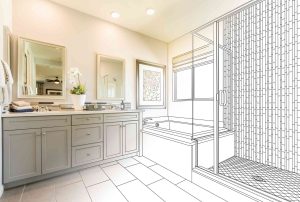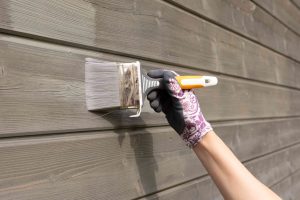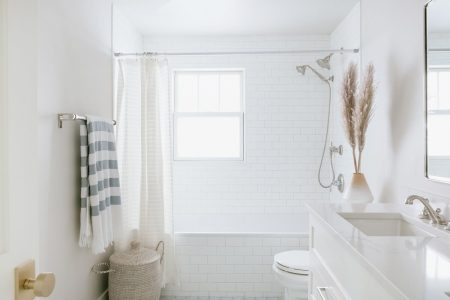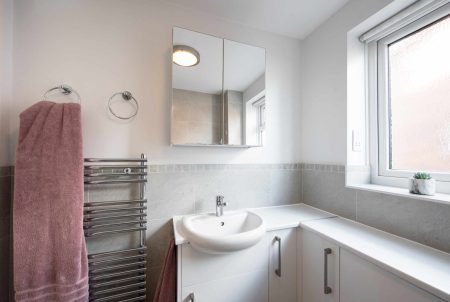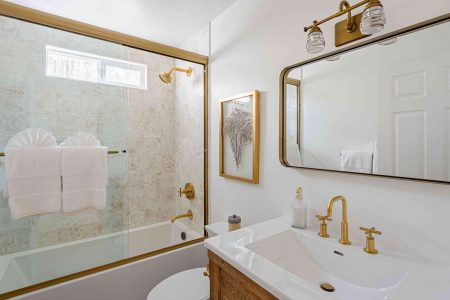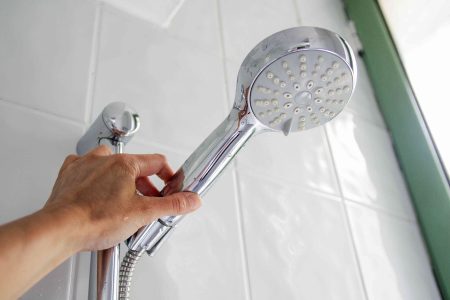Unfinished basement space often goes unused for anything more than storage, and even finished basements often lack a bathroom, forcing guests and household members alike to climb up at least one flight of stairs when they need to use the facilities. Basement bathrooms are a great way to use the entire home efficiently. They appeal to homeowners that plan to continue living in the house and they are also attractive to prospective buyers, typically leading to an increase in the value of the home.
However, the process of installing a basement bathroom consists of several steps that must be handled by a professional in order for the bathroom to pass an inspection and satisfy building permits. The cost of materials and hiring professionals to complete the work often deters homeowners from pursuing this upgrade, but there are many steps that can be completed by an experienced DIYer to help reduce the overall cost. Take a look at this guide to everything you need to know about installing a basement bathroom before deciding whether this upgrade is right for your home.
Pros and Cons of Installing a Basement Bathroom
While installing a basement bathroom is a costly project that isn’t DIY-friendly, homeowners will see an increase in the overall value of the home and increase in ROI. Additionally, the convenience of having a nearby bathroom typically outweighs the drawback of the space that the bathroom takes up. Also, a bathroom is one of the necessary additions for any rental space, so this project may be the first step towards being able to monetize your unused basement. Overall, adding a basement bathroom is a great idea for anyone with the time and budget.
-
Convenient location
-
Increase home value
-
Create rental space
-
Costly project
-
Professionals required
-
Takes up basement space
Assess the Costs
One of the major drawbacks to installing a basement bathroom is the costs involved because, depending on whether you are installing a small half-bath or a lavish full-bath, you can expect to pay between $8,000 to $15,000 on average. While you can save about $500 to $1,000 if the home already has a rough-in drain system installed, which is becoming more common in newer homes, there are still significant plumbing, electrical, carpentry, and material costs associated with this project. Consider the following breakdown when deciding on the design for your basement bathroom.
| Labor, Parts, and Permits | Average Cost |
|---|---|
| Rough Plumbing | $1,000 to $10,000 |
| Electrical | $500 to $2,500 |
| Drywall and Framing | $1,000 to $3,000 |
| Tile Floor | $900 to $3,000 |
| Permit | $50 to $2,000 |
| Lighting Fixtures | $150 to $900 |
| Vanity | $500 to $4,000 |
| Faucets | $150 to $350 |
| Toilet | $200 to $600 |
| Towel Rack (Optional) | $20 to $100 |
| Bathtub (Optional) | $1,400 to $7,000 |
| Glass Shower Door (Optional) | $500 to $1,400 |
| Shower/Bath Liner (Optional) | $2,000 to $6,000 |
| Shower (Optional) | $2,000 to $8,500 |
Also, keep in mind that the hourly rates for plumbers, electricians, and carpenters vary depending on the location, experience level of the technician, and licensing level. Choose professionals that are capable of meeting your expectations for the project, but that also have a rate that falls within your budget to avoid surprises when the basement bathroom is complete.
Return on Investment
You may already have the budget to dedicate to installing a basement bathroom but are wary about your potential return on investment (ROI). However, this fear is usually unfounded. As long as the bathroom installation is completed according to local building codes with the authorization of a building permit, you can expect a great ROI. This means that when the home sells, you can expect the bathroom to increase the cost of the home by much more than the initial cost of the bathroom installation.
Adding a basement bathroom to a home that currently only has a single bathroom won’t just increase the value of the home, but it will also make it much easier to sell the home because most prospective homebuyers are more interested in properties with two or more bathrooms.
Building Permit Requirements
When it comes to adding a basement bathroom, it’s likely that you will need to have new water lines, drainage lines, and electrical connections installed. This means that you will need a building permit to ensure that the work is being completed according to code. If you choose to take on this project without obtaining the proper work permits, there is the chance that the local inspectors may stop by with a ‘stop-work’ order and shut your project down. They may also find it appropriate to fine you and prevent any further work until the appropriate permits are obtained.
To avoid dealing with fines and unnecessary paperwork, make sure to apply for a permit ahead of time so that your bathroom installation is approved. Typically, building permits for most renovation work ranges from about $50 to $2,000, but the cost is worth it to ensure that the work is done up to code.
Project Difficulty
The idea of putting in a bathroom can seem simple enough to an experienced DIYer, but many people overlook the complications of having to dig up the concrete foundation in order to run drainage lines at the appropriate angle for efficient waste disposal and to avoid clogs. Running new wires to the bathroom may be within your skill set, but it’s also necessary to ensure that the new circuits are connected properly to the main electrical panel, which is a task best left to a master electrician.
Overall, installing a basement bathroom is a project that is best handled by one or more licensed professionals. However, experienced DIYers may want to take on parts of the project to help reduce the overall costs. Some steps that are more DIY-friendly include installing the vanity, putting up drywall, installing the faucets, and even tiling the floors. Just make sure that every stage of the installation follows the appropriate building codes in order to avoid potential problems in the future, like a leaking foundation.
Basement Bathroom Installation Process
While many aspects of this job are not suited for DIYers, it’s still important to understand each step of the installation process in order to ensure that you are on the same page with your contractors. If you are unaware that the concrete floor needs to be broken to run drainage lines, then the sight of a handheld jackhammer might cause surprise and concern. So, instead of trying to navigate through several key design decisions without actually understanding the importance of each choice, take some time to familiarize yourself with this overview of the entire basement bathroom installation process, as well as the tasks that are DIY-friendly.
Design the Bathroom
Before you can start to do anything with your unused basement space, it’s important to have a plan in mind for how you want the new basement bathroom to look. This means that you will need to consider whether you are installing a small half-bath with just a toilet and a sink, a three-quarter bath with a toilet, sink, and shower, or a full bath, including a toilet, sink, shower, and bathtub.
Beyond these initial concerns, you will also need to figure out how big you want the bathroom to be and the most appealing layout for the main fixtures in the room. Additionally, you need to decide on the specific faucet, sink, toilet, vanity, shower, bath, and lighting fixtures that you want to be installed. Also, don’t forget to choose the tile type, tile color, and paint color to finish off the bathroom.
While not every detail needs to be decided before construction begins, it is important to at least have an idea of what you want, so that you can be sure to keep the design true to your ideal outcome.
Measure and Mark Wall Locations
Installing a basement bathroom begins with figuring out where to run the outer walls of the room. During the planning process, you should have decided on an estimated size or area for the basement bathroom. Use this information to measure and mark the exact locations for the outer walls of the bathroom. Just keep in mind that the concrete floor will still need to be broken up to run drain lines, so the walls will not be installed until after the drainage pipes are in place.
Measuring and marking the walls for the new bathroom is a step that can be handled by an experienced DIYer. However, if you have already hired a professional to complete the carpentry work, then they should measure and mark the wall locations as part of the wall rough-in process.
Position the Drains
With the wall locations clearly defined, you can mark the position of the shower and toilet drains. Typically, this plan is best discussed with the plumber that will be running the drain lines, so that you can come up with the ideal location with minimal drainage difficulties. Use a general measurement of the shower stall or bathtub to determine where the shower drain should be placed.
Position the toilet drain about 1 1/2 feet away from the wall. This should give you enough space for an appropriate fit, but if you are unsure about the layout of the bathroom based only on measurement, consider bringing the actual toilet into the space in order to see exactly how it would fit. This will help you make an informed decision and keep the project moving forward.
Break Up the Concrete
One of the main problems with installing a basement bathroom is that it often requires running long, horizontal drainage pipes that are prone to clogging. For this reason, it’s important to have a professional plumber involved in planning the drain line layout, digging pipe trenches, and installing the drainage pipes.
During this step, the plumber will often use a jackhammer to break up parts of the concrete floor in the bathroom. The purpose is to create trenches where the drain pipes can be installed to connect the toilet and shower to the main drain line.
Install Floor Drain Lines
Once the trenches have been dug, the plumber can begin to install the drainage pipes from the main sewage line to the bathroom. The pipes will need to be measured, cut, and pieced together so that they fit comfortably in the trenches that the plumber has dug in the concrete. This step should always be handled by professionals to ensure that the plumbing is installed to code and will not have issues with drainage or leaks.
Rough-in Walls
The framework for the bathroom can be installed at this point so that it can be used to support the vertical drain pipes, ventilation pipes, and water supply pipes that will need to be run to complete the plumbing. Experienced DIYers can typically handle this part of the project: Just make sure to accurately follow the previously measured and marked wall locations to avoid potential alignment problems during drywall installation.
Install Vertical Drain and Ventilation Pipes
The next step in the process is to have a plumber install the above-floor vent pipes, and branch drains for the sink, as well as connect these lines to the roof vent stack for proper ventilation. The reason these lines are installed after the framework for the room is so that the drain and ventilation pipes can be attached to the wooden studs for support. Without the proper support, too much stress on a single joint can crack the pipe, resulting in terrible odors, leaks, and extensive water damage hidden behind the walls.
Ventilation lines are often overlooked by inexperienced DIYers, but these pipes are necessary to prevent hazardous sewer gas from building up inside the home. Instead, the waste is directed down into the sewer lines via ejector pumps, while the gas is released from a vent on the roof of the home.
Run Water Supply Lines
Having a reliable professional plumber is necessary for a relatively low-stress basement bathroom installation because there are so many parts of the process that rely on experience, skill, and knowledge that isn’t DIY-friendly. Running the hot and cold water lines to the toilet, sink, and shower/bath is another part of this installation that is best tackled by a professional plumber.
They will be able to assess the area and make a plan for efficiently running hot and cold water lines into the bathroom and to the various plumbing fixtures. Typically, the plumber will install copper water lines, though some plumbers will opt for the more affordable PEX pipe. If you have a certain material in mind, make sure you mention it to your plumber.
Install Electrical Wiring
After most of the plumbing work is done, you will want to find a licensed electrician to run new wires from the main electrical box to the bathroom. The purpose of these electrical wires is to provide power to lighting fixtures, power outlets, and baseboard heaters, if necessary. However, the actual fixtures will not be able to be installed until the drywall and ceiling are finished.
Basic wiring may be able to be handled by an experienced DIYer, but it’s recommended to leave this part of the job to a licensed professional so that you can be certain that the bathroom will pass an inspection.
Lay Tile Floor and Put Up Drywall
It’s a good idea to have an inspector come and take a look at the plumbing, electrical, and framework for the bathroom before covering it up with tiles and drywall. Once it has gotten the OK, you can pour new concrete to fill the trenches, then install the floor. If you aren’t familiar with the process of installing a tile floor, then you may want to hire a carpenter to complete the work to get the desired result.
Most DIYers will be able to install a drywall ceiling and walls without too much difficulty. Just make sure to measure and cut holes for any water lines, drain pipes, or electrical fixtures that protrude from the wall. This also includes lighting fixtures that will be mounted on the wall.
Keep in mind that if you are installing a shower or bath, then you will need to install tiling on the walls inside the bath or shower stall to prevent water damage during regular use.
Install a Vanity, Toilet, and Other Fixtures
At this point, the vanity, toilet, and electrical fixtures can be installed. You may also want to install a shower or bathtub, depending on whether the plan is for a half-bath, three-quarter bath, or full bath. While modest finishing work, like putting in the toilet or installing a new faucet, can be handled by the average DIYer, it’s recommended to hire a plumber to install a shower or a bathtub. Additionally, the installation of a basic sink and vanity are well within the skills of an experienced DIYer, but this task can also be handled by a hired carpenter if you would prefer to leave it to a professional.
The electrical fixtures should be relatively straightforward to wire and mount if the main wiring has been run correctly, but if you don’t have experience working with electrical systems or don’t feel comfortable wiring up these fixtures, it’s best to have an electrician make the final connections.
Add Trim and Paint
The last step in completing this basement renovation project is installing the trim and painting the walls. Trim can be tricky for newer DIYers, but experienced individuals will have no problem making angled cuts to slot the pieces of trim in perfectly around the borders of the room. Choose a color of paint that will match or highlight the plumbing and lighting fixtures that you have selected for the bathroom. Make sure that the type of paint is made for use in bathrooms, kitchens, and high-humidity locations to help protect the drywall and prevent water damage.
Read the full article here



